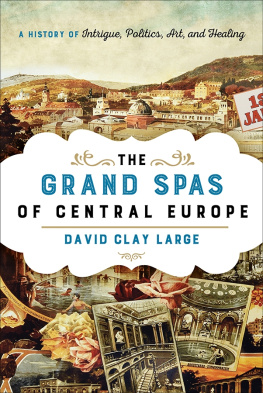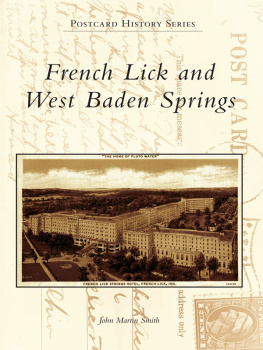The Grand Spas of Central Europe
Also by David Clay Large
Munich 1972: Tragedy, Terror, and Triumph at the Olympic Games
Nazi Games: The Olympics of 1936
And the World Closed Its Doors: One Familys Abandonment to the Holocaust
Berlin
Where Ghosts Walked: Munichs Road to the Third Reich
Germans to the Front: West German Rearmament in the Adenauer Era
Contending with Hitler: Varieties of German Resistance in the Third Reich (editor)
The End of the European Era: 1890 to the Present (with Felix Gilbert)
Between Two Fires: Europes Path in the 1930s
Wagnerism in European Culture and Politics (co-editor)
The Politics of Law and Order: A History of the Bavarian Einwohnerwehr, 19181921
The Grand Spas of Central Europe
A History of Intrigue, Politics, Art, and Healing
David Clay Large
Rowman & Littlefield
Lanham Boulder New York London
Published by Rowman & Littlefield
A wholly owned subsidiary of The Rowman & Littlefield Publishing Group, Inc.
4501 Forbes Boulevard, Suite 200, Lanham, Maryland 20706
www.rowman.com
Unit A, Whitacre Mews, 26-34 Stannary Street, London SE11 4AB
Copyright 2015 by Rowman & Littlefield
All rights reserved . No part of this book may be reproduced in any form or by any electronic or mechanical means, including information storage and retrieval systems, without written permission from the publisher, except by a reviewer who may quote passages in a review.
British Library Cataloguing in Publication Information Available
Library of Congress Cataloging-in-Publication Data
Large, David Clay.
The grand spas of Central Europe : a history of intrigue, politics, art, and healing / David Clay Large.
pages cm
Includes bibliographical references and index.
ISBN 978-1-4422-2236-6 (cloth : alk. paper) ISBN 978-1-4422-2237-3 (electronic) 1. Health resortsEurope, CentralHistory. 2. Europe, CentralSocial life and customs. 3. Europe, CentralPolitics and government. I. Title.
RA846.L37 2015
613'.122094dc23
2015017468
 The paper used in this publication meets the minimum requirements of American National Standard for Information SciencesPermanence of Paper for Printed Library Materials, ANSI/NISO Z39.48-1992.
The paper used in this publication meets the minimum requirements of American National Standard for Information SciencesPermanence of Paper for Printed Library Materials, ANSI/NISO Z39.48-1992.
Printed in the United States of America
For Hans Rudolf Vaget, Native Son of Marienbad
Thousands have lived without love, not one without water.
W. H. Auden
Fons Levit Inalidos
Animum Qui Vertit Ad Artem
Emendat Mores
Excolit Ingenium
(Just as the bubbling spring revives and helps
the sick body, it leads the mind to art and
ennobles the customs and spirit.)
Inscription at Elisabethbrunnen, Bad Homburg
Captain Renault: What in heavens name brought you to Casablanca?
Rick: My health. I came to Casablanca for the waters.
Captain Renault: The waters? What waters? Were in a desert.
Rick: I was misinformed.
Casablanca

Contents

Introduction
In recent years the word spa has become ubiquitous, almost as unavoidable as sustainable. Thus it should come as no surprise that there are sustainable spasplaces like Dune Echo Village in Pondicherry, India, where you can get your deep-muscle massage and colonic evacuation while simultaneously saving the planet. Yet these green health resorts are merely the surface of the pool when it comes to the spa phenomenon in our time. According to a Global Spa Summit held in 2007 at the Waldorf-Astoria Hotel in New York City, the international spa industry raked in forty billion dollars the previous year. Today there are more than ten thousand spa locations in the United States alone, and this figure does not include beauty parlors offering spa treatments, airport XpresSpas, or those countless backyard hot tubs marketed, rather cheekily in my view, as spas. The International Spa Association is happy to report that spas are increasingly displacing golf resorts as the venue of choice for corporate retreats. Golf isnt relaxing, notes a sales director for Canon Industries, its very competitive and adds more to the stress. Spas, on the other hand, provide a good chance to network and talk in a relaxed atmosphere.
The spa treatments to which stressed-out businesspeople and health seekers of all sorts flock these days vary wildly from standard thermal-spring bathing to wallowing in beer baths (Czechoslovakia), practicing underwater shiatsu (Thailand), rolling in herb-scented hay (Zermatt, Switzerland), being scrubbed with sea salt and Javanese spices (Vienna), getting massaged with linen-wrapped hot stones while listening to Greensleeves (Santa Barbara, California), sitting for hours in lithium-laced pools (Chinati Hot Springs, Marfa, Texas), enduring the back, sack, and crack male Brazilian wax treatment (London), or having your face slimed by giant African snails (Russia). Should you prefer a purely armchair healing experience, I recommend Fay Weldons novel The Spa (2007), which showcases a moat-encircled retreat in the northern English countryside available only to high-achieving ladies who pay a small fortune for a few days of Botox, aromatherapy, and group testimonials la Chaucer.
As lively and variegated as todays international spa scene may be, however, it is really just a faint echo of a much more potent and vital natural-cure culture based on healing waters that prospered in Europe from pre-Roman times to the First World War, with a long coda stretching into our own day.
There were always, of course, other forms of natural health therapy in addition to the healing waters, including herbal remedies and the so-called air cure, which relied on the putative therapeutic properties of dry desert or mountain air to treat respiratory afflictions like tuberculosiswitness the seven-year cure undertaken by the fictional Hans Castorp in Thomas Manns novel The Magic Mountain (1924) or the tubercular Doc Hollidays real-life struggle to prolong his days as a gun-slinging dentist by moving from Atlanta to the American Southwest in the 1880s. (Recent research indicates that the high-elevation air cure may actually be useful in treating drug-resistant strains of this disease, since reduced atmospheric pressure inhibits the ability of M. tuberculosis to survive and multiply.)
But it is hot water, not dry air, which is of central concern in this narrative, in which we will meander through the convoluted world of hydropathy and balneology (as the science of therapeutic bathing is called).
The story of thermal spas is importantnot least in the history of medicine and personal health. We may think that we are long past the days when the water cure stood at the forefront of medical treatment, but that is not the case. Until only very recently, conventional internal medicine in the industrialized world could not offer much alternative to the benefits of taking the waters. In many instances, healing waters provided as much symptomatic relief as (if not more than) any other remedies then available for arthritic, respiratory, digestive, and nervous ailments. Of seventeenth-century medicine it has been said: Nearly all men died of their remedies and not of their diseases. Later on, the use of electrified beds to drive tapeworms from the body in late nineteenth-century European hospitals suggests, for example, that modern technology was not necessarily a blessing. True, for major afflictions such as cancer or occluded arteries, water therapies could be something of a curates eggnot nearly what they were cracked up to be. Yet even in the dire straits of mortal illness there was (and is) much to be said for the spa treatments placebo effectand at least with healing water, the cure was not (generally) more painful than the disease.
Next page












 The paper used in this publication meets the minimum requirements of American National Standard for Information SciencesPermanence of Paper for Printed Library Materials, ANSI/NISO Z39.48-1992.
The paper used in this publication meets the minimum requirements of American National Standard for Information SciencesPermanence of Paper for Printed Library Materials, ANSI/NISO Z39.48-1992.
